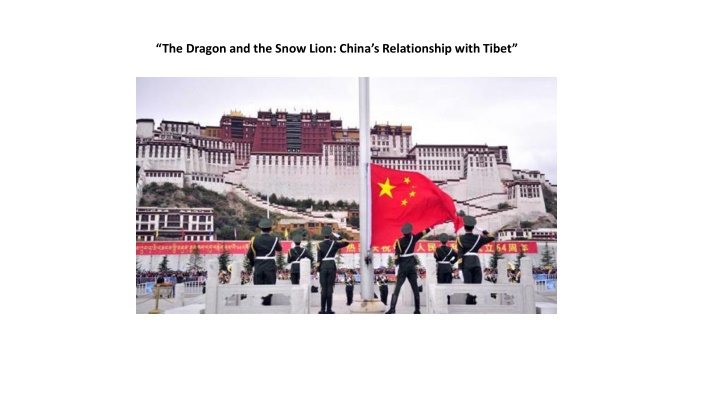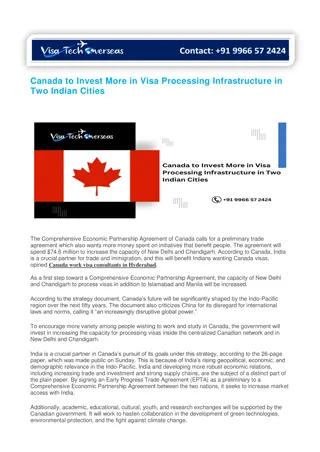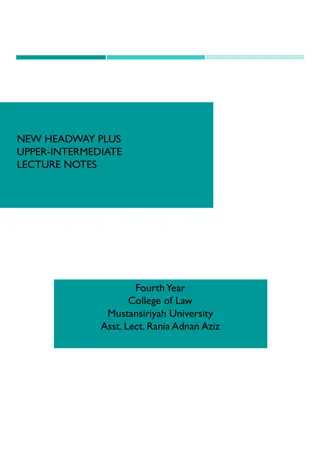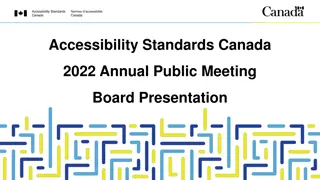Canada's Relationship with Tibet: From Past to Present
Exploring the historical connections between Canada and Tibet, from early Canadian missionaries in the late 19th century to the welcoming of Tibetan refugees in the 20th century. The narrative includes significant figures like Dr. Susanna Carson Rijnhart and the first Tibetan refugees arriving in Canada. It also touches upon different stages of refugee settlement and the evolving dynamics of the relationship between the two regions.
Download Presentation

Please find below an Image/Link to download the presentation.
The content on the website is provided AS IS for your information and personal use only. It may not be sold, licensed, or shared on other websites without obtaining consent from the author.If you encounter any issues during the download, it is possible that the publisher has removed the file from their server.
You are allowed to download the files provided on this website for personal or commercial use, subject to the condition that they are used lawfully. All files are the property of their respective owners.
The content on the website is provided AS IS for your information and personal use only. It may not be sold, licensed, or shared on other websites without obtaining consent from the author.
E N D
Presentation Transcript
The Dragon and the Snow Lion: Chinas Relationship with Tibet
Canada and Tibet: Susanna "Susie" Carson Rijnhart, 1868 1908, Chatham, Ontario One of the first woman allowed to study medicine at Trinity College in Toronto, (1889): The Ist Western women to enter Tibet : From the late 19th Century to the early 20th Century: Tibet was a place of Canadian missionaries.
On a lecture tour of Canadian churches, Dr Rijnhart was described as a Canadian heroine with a most thrilling story of missionary exploration, sacrifice, and possible martyrdom.
Prominent Victorian connected with Tibet 1870 1945) was the British Political Officer for Bhutan, Sikkim and Tibet. In 1921 Bell retired Civil Service and moved to Victoria, BC
Twice Diaspora Twice Diaspora Tibetans in Canada: Tibetans in Canada:
The Prime Minister Pierre Trudeau welcomes Tibetans: In June 1969, Canada became a signatory to the 1951 un Convention Relating to the Status of Refugees In March 1971, the first Tibetan refugees arrived in Canada. This small group of newcomers to Canada became the first non-European refugees accepted into the country. At the time, the settlement of these refugees called for Quebec, Ontario, Alberta and British Columbia to accept an equal number of refugees.
Three stages: The first group 1970 (humanitarian gesture) The second stage 1990-2010 (Migration The third stage, 2010- Present (Private Sponsorship)
Xizang . Bo Tibet
https://www.chinafile.com/reporting-opinion/viewpoint/how-much-does-beijing-control-ethnic-makeup-of-tibethttps://www.chinafile.com/reporting-opinion/viewpoint/how-much-does-beijing-control-ethnic-makeup-of-tibet
Han/Chinese population 91.96 percent 8.04 percent belong to minority ethnic groups
Xizang. In August the ministry of propaganda issued a directive to gradually replacing Tibet with Xizang in external propaganda: Refers only Tibet Autonomous Regions: Tibetan Population 2020: TAR: Qinghai: 2021.170 Sichuan: 1990.585 Gansu: 367.006 Yunnan 387.511 3137.901
July 23 2021 Xi Jinping became the first President of China to visit Lhasa :
July Xi Jinping became the first President of China to visit Lhasa. Xi s visit timed to coincide with the 70th anniversary of the 17 Point Agreement Marking the centenary celebration of the founding of CCP
The Seventeen Point Agreement: The formal title, Agreement of the Central People's Government and the Local Government of Tibet on Measures for the Peaceful Liberation of Tibet, Signed in 23 May 1951
Deng was the architect of the 17th Point Agreement, at the Deng was the Political commissar of SW Military Region, that army that invaded Tibet. The 17 Point Agreement is almost identical to Hong Kong Basic Law signed with Britain by Deng Xiaoping and Margaret Thatcher
The latest Development : On 18th of October, Wang Junzheng asenior official sanctioned by the United States, Britain, the European Union and Canada for his role in China s far western Xinjiang region has been appointed the First Sec of CCP in Tibet, (the top job).
What are the issues? 1) Minority areas: Resource Rich, Resource extraction, Low population density 2) Migration/ Settler Colonialism/ Sinicization/ Population transfer. 3) Economic disadvantage, imbalance growth 4) Chinese elite, no connection with minority issue 5) International dimensions. Human Rights Global Diaspora/ Soft Power/ China s image.
Key themes: 1947-1960 Sovereignty. Securing frontier (China signed a major border agreement with neighboring countries 1960-1967 Reform/ 1967-1979 Socialists Transformation 1979-1990 apology) Autonomy Revisioned, (Hu Yaobang s 1990-2000 Economic Development (Western Development, ;) 2000-Present Integration and Assimilation/Civic Citizenship
PRC/ CCPs Paradigms 1) Liberation/Unification 2) Emancipation 3) Development
Tibetan Grievances Total number of Self-immolations: 155 (129 Male and 26 Female),
1) Religion: CCP/the State interference in purely religious affairs 2 Language / Education Residential/ Boarding schools 3)Jobs/Economic/ forced resettlement of nomads. 4) Forced Sinicization Loyalty to China diminish Tibetan identity. Population transferred; Resettlement of Nomads/ Introduction of common language education
When Xi Jinping came to power in 2013, he set a goal to completely overcome poverty by 2020.
Canada and Tibet China asserts and tries to influence global opinion.
China is funding and setting up groups in Canada disguised as genuine community lead groups. They lobby MPs, MMP and Businesses
My country or my religion: CCP Religion Ideology Socialism with Chinese characteristics Buddhism, Christianity, Islam, Leadership Party Sec, Central Committee Religious leaders, e.g. the Dalai Lama, Organization The Party Church/ Religious sects and groups Membership CCP membership/ 85 Million 244 Million Buddhists, 67 Million Christians 21 Million Muslims























